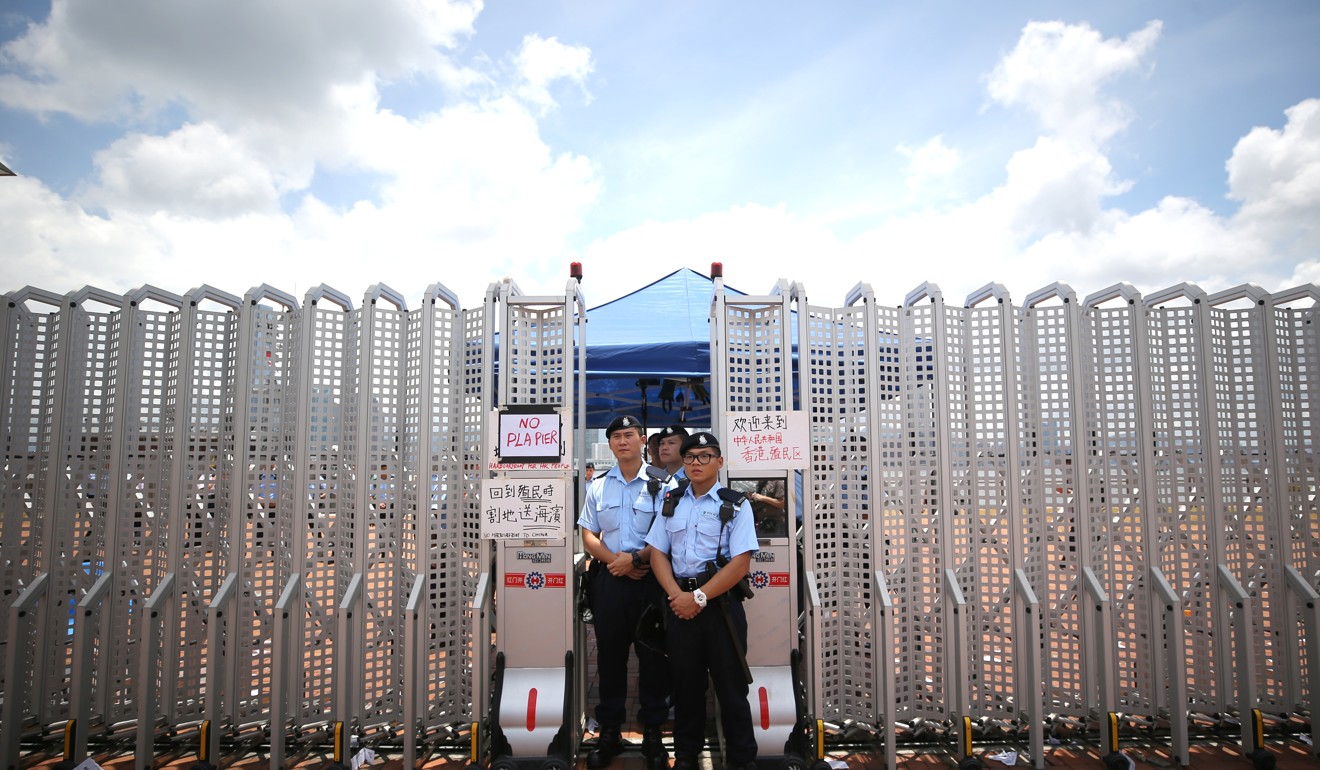
Protesters and police in tense new stand-off at site of PLA dock on Hong Kong harbourfront
- Lawmakers and conservation group challenge officers guarding 150-metre strip of land alongside Victoria Harbour
- Clash comes hours after riot police clear hundreds of protesters from site
Opposition lawmakers Eddie Chu Hoi-dick, Ted Hui Chi-fung, and Fernando Cheung Chiu-hung, along with a handful of members from the Protect the Harbourfront Alliance concern group, were kept outside a fence as about 30 police officers stood guard at the 0.3-hectare strip.
“Return the harbourfront to the Hong Kong people! No PLA pier!” the group chanted.
The group was protesting against the government’s move to hand over the prime 150-metre stretch of land to the PLA Hong Kong Garrison.

Late Friday night, Chu had led a small group of protesters to occupy the strip, climbing over the fence to hang banners as part of the latest protest, which followed on the heels of a series of rallies against the extradition bill over the past few weeks.
Around 100 riot police cleared the site minutes before midnight on Saturday, when it legally became a military dock under PLA ownership.
Extradition bill protesters had originally planned to show up to picnic outside the site, but were notably absent on Saturday morning.
A poll in a Telegram group with 40,000 subscribers asked protesters shortly after the occupation of the site on Friday night if they wanted to continue on Saturday, or to reserve their energy for July 1, when an annual pro-democracy rally is expected to take place.
Of 7,172 votes, some 83 per cent said they preferred to rest on Saturday and to continue the protest on Monday.
5,000 riot police on standby for Hong Kong handover day
Only Chu and his group showed up at around 11am on Saturday. The lawmaker attempted to enter the site about 30 minutes later, and said those in attendence were exercising their rights to peacefully protest at a public site, resulting in a tense stand-off with officers.
“The government has promised us for more than a decade that when the site is not being used by the PLA, it would be open for the public, just like any public space,” Chu said.
“Can you tell us why us seven ordinary Hong Kong citizens are not allowed to go to a public place to protest? Are police acting as security guards for the PLA now?”
Police repeatedly warned the group to leave the area.
“This is already a protected area. This is the police defence’s line. Do not charge at the defence line,” a commanding officer said.
“You are not authorised to enter this protected area. If you insist on doing so, you may be subject to criminal prosecution.”

The Security Bureau told lawmakers in May that the PLA Garrison would consider in future “opening the movable gates enclosing the central military dock to allow members of the public to enter the part of the dock” outside the four PLA buildings.
By designating the area as protected, the Bureau said at the time: “This will facilitate the garrison in considering in future allowing members of the public to enter the concerned area, without the need for issuing individual permits, under the condition that the defence functions would not be affected.”
Under the law governing protected places, any unauthorised entry and failure to leave the immediate vicinity as requested, could result in six months in prison and a fine.
The group eventually left shortly after midday, but vowed to return.
The Chinese and British governments agreed in 1994 to leave a 150-metre stretch of the harbourfront as a military dock, but that had not happened over the past 20 years.
Amnesty for both protesters and police the best way forward
The area was originally part of the harbourfront open space, before the government applied to change the land use in 2013, a move the Town Planning Board endorsed the following year.
Paul Zimmerman, a member of the Harbourfront Commission, the watchdog that advises the government on the waterfront, said: “This is one of the most important sections of the harbourfront for public access, especially to watch the dragon boat races.
“This government is tone deaf. We’ve worked so hard for the past 17 years trying to make sure the harbour would be returned to the people, I need to apologise to the public for not being able to stop this nonsense.”
The PLA occupies 19 sites it inherited from the British military when the city returned to Chinese rule in 1997. But under the Garrison Law, if the local government requires any part of a military site for public use, it can seek approval from Beijing.


